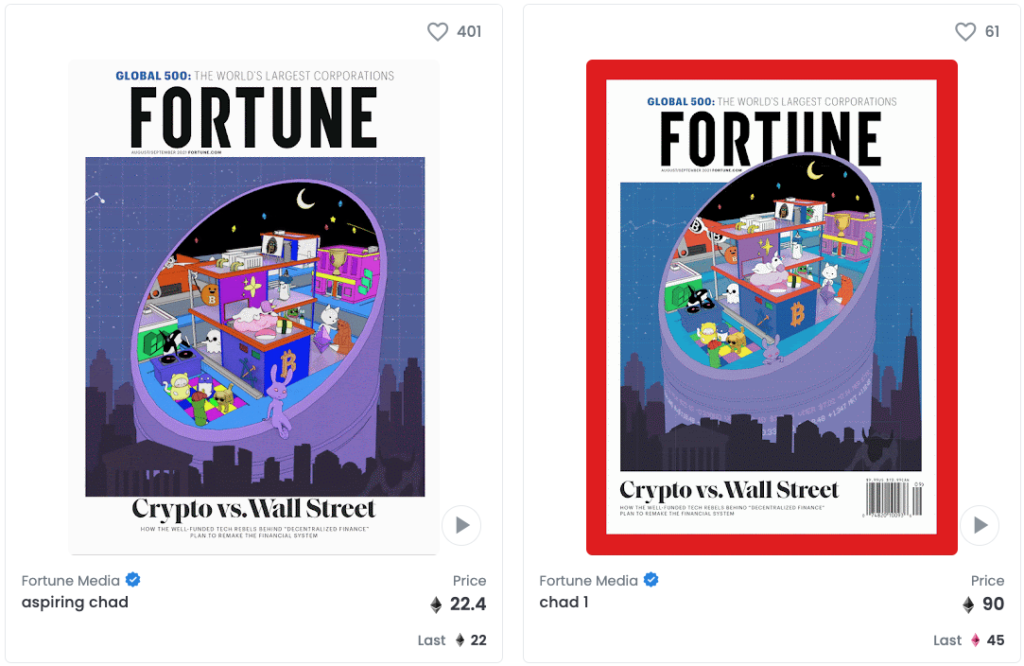The NFT explosion, which began in March 2021, was driven, in part, by mainstream media coverage of NFTs: from high-priced sales to brands experimenting in the space. But mainstream media outlets also jumped into the world of NFTs themselves with a variety of news-related releases, from classic covers to historical news items. A recent effort by Fortune included a group of NFTs based on digital artist Pplpleasr‘s cover for its August/September issue. Though noteworthy for combined sales of 429 ETH, currently valued at $1.3 million, Fortune‘s success with NFTs is also representative of what can happen when mainstream media embraces rather than ridicules emergent cultural efforts.
Magazine Covers as NFTs
Magazine covers offer one particularly ripe area of exploration. For example, TIME drew on and updated its history with a series of three NFTs released in March, “including one of the most iconic covers in TIME’s 98-year history, and the first-ever cover designed exclusively as an NFT.” The total take from the three NFTs was $446,000 worth of ETH and became a relatively early indicator that NFTs could be more than a marketing tool and might well become a significant revenue source.
Of course, mistakes were made. Forbes claimed in April to be the first to turn a magazine cover into an NFT, reminding one that TIME could have put out a “Fact-Checking Is Dead” cover as well. Such failures during this period were quite common, with many “first-ever” claims from media outlets, pr firms and corporate tweeters that were readily dismissed with a simple Google search.
Oddly enough, SPIN, which is now all-digital, announced NFTs in March that “classic covers” were coming soon but it has yet to follow through. It seems to have gotten stuck at the collecting emails stage.
Fortune Goes All In
Some media outlet experiments, such as that of the NY Times, were presented with a somewhat baffled “Why Did Someone Pay $560,000 for a Picture of My Column?” perspective. In contrast, Fortune seems to be embracing not only NFTs but the world of blockchain as well. In a recent package of articles covering NFTs, crypto, and DeFi, Fortune showed that a very mainstream media outlet could, in fact, find writers who can understand what’s happening in this new world and can communicate it without the need to crack jokes.
Signaling buy-in from the very top, Fortune CEO Alan Murray titled his daily newsletter discussing the package, “Fortune is all in on blockchain.” Fortune‘s approach, and this collection of articles, is an impressive move, and one hopes this quality of coverage continues. But, ironically, its ranking of the NFTy50, which we will probably now see annually, is strongly off the mark, including numerous famous people who would be best described as dabblers in NFT Land.
Nevertheless, many key players in the space are included, and the questionable entries are more than balanced out by folks playing essential roles that predate the 2021 boom. One artist on the list, pplpleasr, was commissioned by Fortune to do a striking cover which was subsequently released as an NFT. Fortune also included an autobiographical piece by pplpleasr sharing her journey into the land of crypto, DeFi and NFTs.
Fortune‘s NFT Cover Art Sales
Outside of Playboy‘s work with Slimesunday, pplpleasr’s Fortune cover is one of the very few mainstream media NFT projects involving an actual crypto artist. In addition, while the published magazine cover designed by pplpleasr is a static image, the NFTs themselves include livelier variations.
The sale on OpenSea occurred in two parts, with an initial offering of 256 images priced at 1 ETH each, followed by a three-day set of auctions of “three special edition NFTs featuring more in-depth graphics.” Though the auctions encountered a variety of difficulties, including denial of service attacks, the combined sales ultimately totalled 429 ETH, currently valued at $1.3 million.
Despite the obstacles to the auctions, Fortune‘s NFT sales were more than a financial success. The effort demonstrated that NFT artists and mainstream media can work together quite productively, especially since many NFT artists now come from commercial backgrounds in such fields as animation and visual effects, as did pplpleasr. It also revealed that mainstream media outlets can indeed cover NFTs and related topics without condescension and tedious attempts at humour.
However, once such coverage becomes mundane, the lasting lesson may be that NFTs offer media companies an opportunity to take a marketing cost center and transform it into a unique revenue center of its own. Given many major media outlets’ successful entry into affiliate content marketing, such as the NY Times‘ Wirecutter, creating NFT commerce operations does not seem much of a stretch. And, in the end, if the often struggling world of media can establish a lucrative new revenue stream, even reluctant editorial staff members are more likely to come around.
Featured Image: Screenshot of Fortune NFTs on OpenSea



